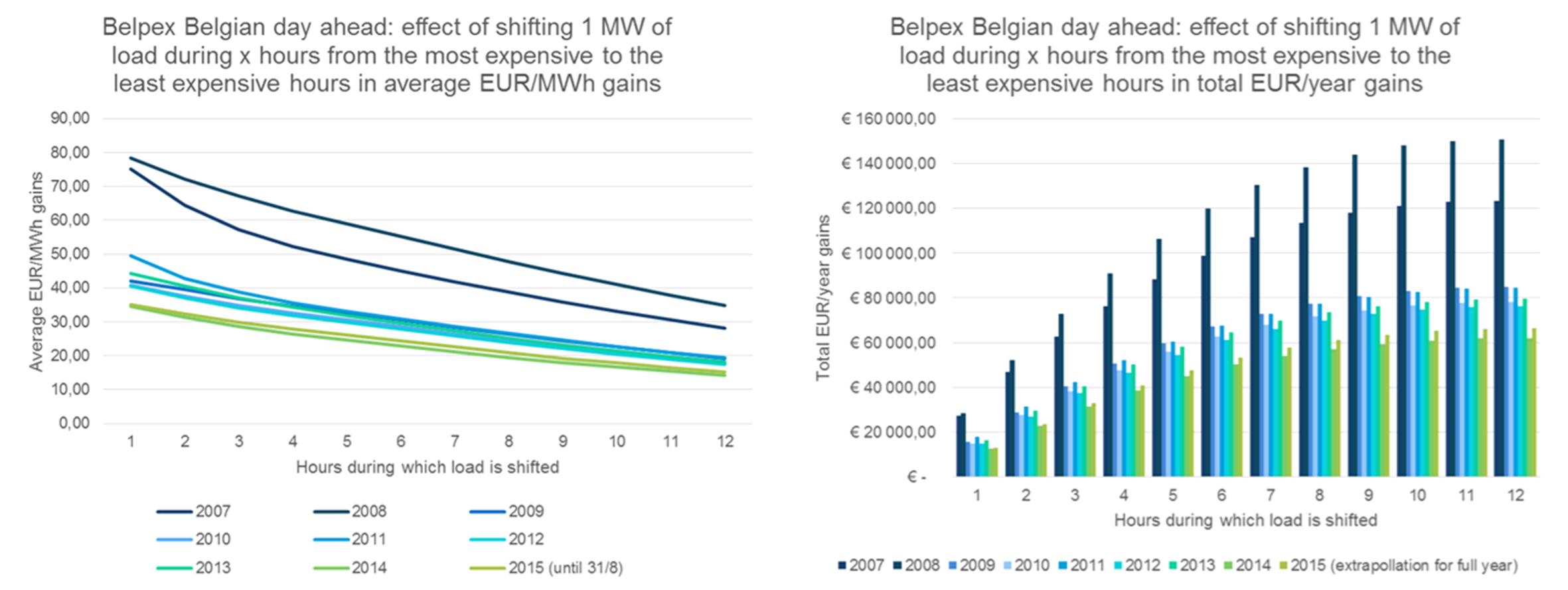By Benedict De Meulemeester on 17/12/2015
Grid balancing, meeting the supply of energy to the demand, has become less predictable with more renewable energy being installed and connected to the grid. Until recently, it was mostly generators that adapted their production in case of the risk of unbalance. Nowadays, industrial consumers sometimes implement Demand Side Management (DSM) which is, briefly explained, adapting the demand in exchange for financial benefits.
What exactly is Demand Side Management?
A consumer using Demand Side Management actually switches consumption on and off to improve its energy prices. In a strict sense, DSM means switching your consumption from hours with high spot prices (when the demand is high) to hours with low spot prices. This impacts the balance of the grid because the consumption during the hours in which supply is tight will go down as a lot of consumers are scaling down their consumption in those hours. Recently, some countries, such as Belgium, the UK or Spain have created or renewed incentives for capacity or load management due to the concerns over security of supply. They have installed or renewed interruptibility service packages, meaning that consumers are paid for keeping a certain capacity available for switching off. Grid operators will switch off such interruptible clients in case of capacity tightness on the grid. This has sparked a renewed interest in capacity management.
Are there any other possibilities next to switching your consumption?
Well, first a client can assess whether he could sell his interruptibility, directly to a grid operator or through an aggregator. Aggregators are companies that specialize in bringing together interruptible capacities and marketing them. Increasingly, we see that the traditional energy suppliers are playing this role aggregators. However, a client shouldn’t forget that traditional peak shaving is still an option. Grid fees still contain large capacity terms, meaning that keeping your capacity continuously below a certain peak pays off. Also, in some countries a careful management of the load can help a client to drop below certain thresholds for getting certain tax exemptions. These different possibilities necessitate an integrated, holistic approach with clients avoiding that a saving on the left side causes a cost increase on the right side. Moreover, clients should be careful that their actions to manage their capacity don’t jeopardize their energy efficiency attempts at managing consumption.
Could Demand Side Management result in serious cost savings?
There is definitely a cost-saving potential although we must say that, contrary to popular belief, the difference between the expensive and the inexpensive hours on the spot markets has gone down during the last years , making demand side management less rather than more rewarding.

This is due to the fact that many energy systems have a lot more flexibility on the production side these days. Client should also always keep in mind that is an arbitrage activity – meaning that inevitably you will see markets get more balanced out if lots of clients apply it, reducing the benefits that you can gain from applying it. It is therefore good to have a very critical look at load management proposals and to carefully weigh its benefits against the extra costs that it could cause.
If I want to start implementing DSM, what should I do or which parties should I involve?
What mostly happens is that people get approached by somebody offering interruptibility services, an aggregator for example, and they spontaneously go down this road. We advise clients to first make a step back and make a holistic study of the different possibilities for your company. How much interruptibility can I offer in terms of megawatts and duration? In this context, companies should have a look at their internal utilities. After having done that you can select the options which are feasible for you and based on that, you can go into the market and see who can give you the best conditions. E&C recommends a market based approach and a holistic approach where you look at all the possibilities of making money with load management. But, of course, not every company can just easily switch their loads. High labor intensity or the necessity of a high utilization rate of the production apparatus can seriously hamper the possibilities of load management. People do not consume electricity just because they love consuming electricity but because they need it. You have to really look into the details and see where you can find flexibility.
Do you think the implementation could have an impact on the electricity prices?
Yes, on two levels. The introduction of incentive programs for DSM could push up the non-commodity price. The transport grid operator in Belgium for example has recently launched a new program for interruptibility services. It is clear that the cost of the grid operator paying money to companies for having interruptibility available needs to be collected somewhere, for example in the prices for the transport grid usage. As far as the commodity price is concerned, like I’ve already point out, DSM is an arbitraging activity, which can reduce the difference between expensive and less expensive hours.
By Benedict De Meulemeester
Feel free to leave a comment and share our blog posts on social media!
E&C is an energy procurement consultancy with an international team of energy experts that offer a unique blend of global capabilities and local expertise.
Our offices in Europe, the US and Australia serve more than 300 clients from South-Africa to Norway and Peru to Australia that have an annual spend between 1.5 million and 1.5 billion dollars.
E&C Consultants HQ
Spinnerijkaai 43
8500 Kortrijk
BELGIUM
+32 56 25 24 25
info@eecc.eu
